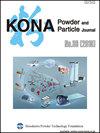Static and Dynamic Stickiness Tests to Measure Particle Stickiness
IF 3.2
4区 材料科学
Q3 ENGINEERING, CHEMICAL
引用次数: 4
Abstract
Sticking of particles has a tremendous impact on powder-processing industries, especially for hygroscopic amorphous powders. A wide variety of experimental methods has been developed to measure at what combinations of temperature and moisture content material becomes sticky. This review describes, for each method, how so-called stickiness curves are determined. As particle velocity also plays a key role, we classify the methods into static and dynamic stickiness tests. Static stickiness tests have limited particle motion during the conditioning step prior to the measurement. Thus, the obtained information is particularly useful in predicting the long-term behavior of powder during storage or in packaging. Dynamic stickiness tests involve significant particle motion during conditioning and measurement. Stickiness curves strongly depend on particle velocity, and the obtained information is highly relevant to the design and operation of powder production and processing equipment. Virtually all methods determine the onset of stickiness using powder as a starting point. Given the many industrial processes like spray drying that start from a liquid that may become sticky upon drying, future effort should focus on developing test methods that determine the onset of stickiness using a liquid droplet as a starting point.用于测量颗粒粘性的静态和动态粘性测试
颗粒的粘着对粉末加工工业,特别是吸湿性非晶粉末产生了巨大的影响。已经开发了各种各样的实验方法来测量在什么温度和水分含量的组合下材料变得粘稠。这篇综述描述了每种方法如何确定所谓的粘性曲线。由于粒子速度也起着关键的作用,我们将这种方法分为静态和动态粘性测试。静态粘性测试在测量前的调节步骤中具有有限的颗粒运动。因此,所获得的信息在预测粉末在储存或包装期间的长期行为时特别有用。动态粘性测试在调节和测量过程中涉及明显的颗粒运动。黏性曲线与颗粒速度有很大关系,所得信息与粉体生产加工设备的设计和运行密切相关。几乎所有的方法都用粉末作为起始点来确定粘性的开始。考虑到许多工业过程,如喷雾干燥,从可能在干燥时变得粘稠的液体开始,未来的努力应该集中在开发测试方法上,以液滴作为起点来确定粘稠的开始。
本文章由计算机程序翻译,如有差异,请以英文原文为准。
求助全文
约1分钟内获得全文
求助全文
来源期刊

KONA Powder and Particle Journal
工程技术-材料科学:综合
CiteScore
8.40
自引率
4.90%
发文量
35
审稿时长
>12 weeks
期刊介绍:
KONA publishes papers in the broad field of powder science and technology, ranging from fundamental principles to practical applications. Papers describing technological experience and critical reviews of existing knowledge in special areas are also welcome.
 求助内容:
求助内容: 应助结果提醒方式:
应助结果提醒方式:


